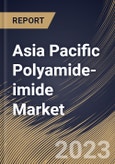Due to low-cost manufacturing and government support in tax benefits and financial incentives, the automotive industry has experienced significant development, particularly in emerging nations. With an ongoing trend towards metal replacement in the automotive and aerospace industries, PAI molding polymers have enormous potential for engine and drive transmission components, which account for approximately half of the automotive component sector. Ongoing research and development activities have led to new grades and formulations of the compound. Innovations are focused on improving material properties, reducing costs, and expanding its range of applications, which, in turn, contributes to market growth.
Over the forecast period, increasing demand for polymers with improved insulating properties will drive market in the electrical and electronics industry. The rising demand for non-stick cookware can be attributed to consumers' growing awareness of fuel-efficient cookware. In addition, the demand for non-stick cookware in Asia Pacific has been influenced by the growing demand for innovative and healthy culinary recipes. Numerous end-use industries, including oil & gas, manufacturing, and construction, have adopted more safety measures in response to stringent occupational health and safety regulations. Also, the heat-resistant properties of PAI fiber are expected to increase demand for the product in fiber applications over the forecast period.
The Asia-Pacific region, especially countries like China and India, has been witnessing rapid industrialization. This growth has increasing demand for high-performance materials like PAI in various industries, including automotive, electronics, and chemical processing. The automotive and aerospace sectors in Asia Pacific have significantly contributed to the market's growth. China could average between 83 GW and 99 GW of new solar capacity annually through 2025. PAI's unique combination of properties makes it well-suited for various applications in renewable energy. The aforementioned factors will significantly expand the market growth across the region.
The China region dominated the Asia Pacific Polyamide-imide Market by Country in 2022 and would continue to be a dominant market till 2030; thereby, achieving a market value of $104,388.2 Thousand by 2030. The Japan region is registering a CAGR of 7.4% during (2023 - 2030). Additionally, The India region would showcase a CAGR of 8.7% during (2023 - 2030).
Based on Application, the market is segmented into Molding Resins, Wire Enamels, Coating, Fiber, and Others. Based on countries, the market is segmented into China, Japan, India, South Korea, Singapore, Malaysia, and Rest of Asia Pacific.
The market research report covers the analysis of key stake holders of the market. Key companies profiled in the report include Solvay SA, Swicofil AG, Kermel, Toyobo Co., Ltd., LG Innotek Co Ltd (LG Display), Fujifilm Holdings Corporation, Huntsman Corporation, Ensinger GmbH, Hitachi, Ltd. and Mitsubishi Chemical Holdings Corporation.
Scope of the Study
Market Segments Covered in the Report:
By Application (Volume, Tonnes, USD Million, 2019-30)- Molding Resins
- Wire Enamels
- Coating
- Fiber
- Others
- China
- Japan
- India
- South Korea
- Singapore
- Malaysia
- Rest of Asia Pacific
Key Market Players
List of Companies Profiled in the Report:
- Solvay SA
- Swicofil AG
- Kermel
- Toyobo Co., Ltd.
- LG Innotek Co Ltd (LG Display)
- Fujifilm Holdings Corporation
- Huntsman Corporation
- Ensinger GmbH
- Hitachi, Ltd.
- Mitsubishi Chemical Holdings Corporation
Unique Offerings
- Exhaustive coverage
- The highest number of Market tables and figures
- Subscription-based model available
- Guaranteed best price
- Assured post sales research support with 10% customization free
Table of Contents
Companies Mentioned
- Solvay SA
- Swicofil AG
- Kermel
- Toyobo Co., Ltd.
- LG Innotek Co Ltd (LG Display)
- Fujifilm Holdings Corporation
- Huntsman Corporation
- Ensinger GmbH
- Hitachi, Ltd.
- Mitsubishi Chemical Holdings Corporation
Methodology

LOADING...








